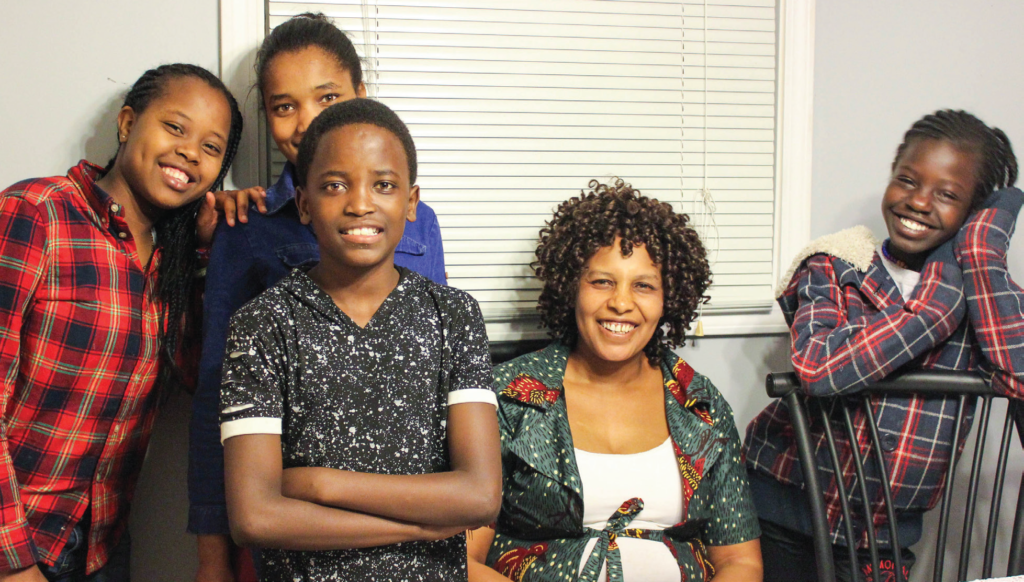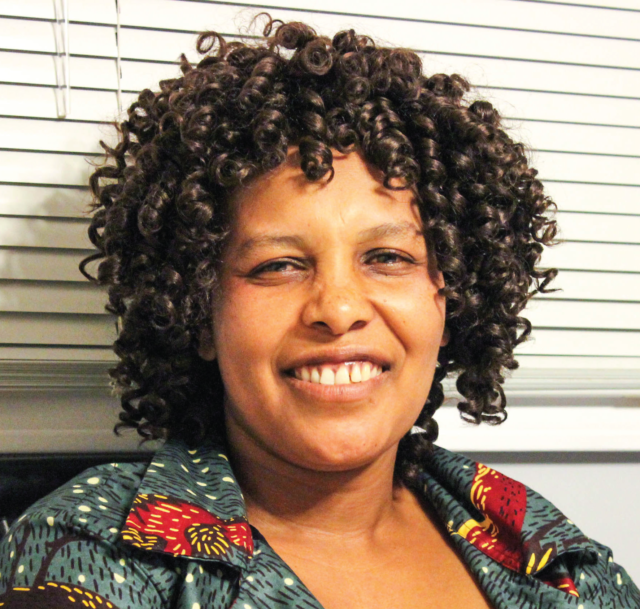“Actually, I feel so excited. I can’t explain it,” says Dorokasi Nzabonimpa, sitting in the first home she purchased in the United States. “I didn’t expect this much.”
She and her family, originally from the Democratic Republic of the Congo, moved into their house less than two months ago. The children are helping to prepare dinner in the next room, listening to music on their phones and singing and laughing in English and Kinyarwanda. It’s already dark and late; Dorokasi is in the middle of her long work week at a meatpacking plant, Swift, in downtown Louisville.
“It’s hard, but I am committed to it and I love it,” she says. She obtained the job four months after being resettled in Kentucky in 2015. First, she started in a packaging position and later progressed to packaging and delivery. She works six days a week to support herself and her six children. Her four brothers all resettled in the United States before her, and she was able to resettle near them.
Buying a home was an early hope, she says, inspired on her drive to see them.
“At the time I reached Kentucky, I went to visit my brother,” Dorokasi explains. “I observed many houses on the way to my brother’s house. I told people who were with me that I would buy among those houses.”
Dorokasi was able to help build her credit in the U.S. through regularly making payments on her travel loan. All refugees resettled in the U.S. receive a travel loan coordinated through a national resettlement agency and the International Organization for Migration (IOM). The loan covers the cost of their entire family’s airfare from their country of asylum to their ultimate destination in the United States. After about six months in the U.S., refugees begin repaying this loan. The funds go towards future refugees’ airfare.
Her journey to resettlement began in 2009 when she and her family were living in the city of Kiwandja. War and violence reached them. She was beaten due to her tribal affiliation, and her husband was tortured and murdered. As a single mother of six children, she was facing a growing war and was forced to flee with her family to neighboring Uganda.
“We could be killed,” she says. “We didn’t have any other area to go to.” Dorokasi explains that the forces who killed her husband followed them and other refugees to Uganda. Her home in the refugee camp was burned. The attackers thought Dorokasi and her family were inside, she says.

As a pastor in an evangelical church, Dorokasi attributes much of where she is now—safe in a new country with her children, able to work and provide for her family, and hoping to see their
dreams come true—to her faith.
“The first dream I had was just praying that God can open the way,” she says. “That my kids can attend school . . . because if they attend good schools, anything they dream they will reach it.”
This year, she’ll see one of her children graduate high school. He plans to enroll in Jefferson Community and Technical College and later attend the University of Louisville. She has opened up her home to others who are resettling and need support. She expects to house a young woman from the Congo soon. She continues to serve as a pastor in her community. Her family has started building a life in Louisville.
Even still, Dorokasi feels stretched.
“I am living a hard life. The entire family—I am supporting them,” she explains. She is also sending money to some children and families she knows in Uganda. “We feel bad because we know how our fellow refugees are suffering back in Africa,” she says.
When she was there, she was helping to care for four Sudanese orphans who had to stay behind. They need food, aid, education, and a future, Dorokasi says. Some of them are in the process of applying for resettlement; others are still waiting. Refugees from Sudan will face stricter screenings under new administration rules. Dorokasi knows the process and she is eager to welcome them if they are approved to come.
“Seeing them coming to the USA,” she says, “is another dream.”
This story first appeared in KRM’s 2017 Annual Report.

You must be logged in to post a comment.